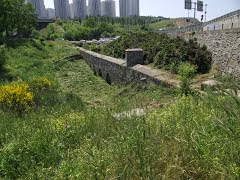Saint Parascheva of Iasi, Thrace (Saint Petka) or Saint Parascheva the New, as it is known, lived in the tenth century. It is important to know and note that there are two more holy slaves with this name: St. Parascheva of Rome (2nd century) and Saint Paraschevi of Iconium. Daughter of wealthy parents who owned many lands, was born near Istanbul today.
Saint Parascheva: the house where she was born
 Where St. Paraskeva once inhabited, a huge church was built on the place where she was born and grew up (in Selimpasa) in honor of the saint. The earliest witness of this church dates back to 1200, and was signed by a Russian hierarch, Antonie, the bishop of Novgorod.
Where St. Paraskeva once inhabited, a huge church was built on the place where she was born and grew up (in Selimpasa) in honor of the saint. The earliest witness of this church dates back to 1200, and was signed by a Russian hierarch, Antonie, the bishop of Novgorod.
In August 1817, the church was completely destroyed by a fire. It has not been more than three years, and it has been rebuilt with the financial support of the citizens of Constantinople as well as those of Moldavia in Wallachia, with the help of Prince Alexandru Callimachi, the prince of Moldavia during May 6, 1795 – March 1799 (The palace reigns Callimachi being, at that time, the first headquarters of the University of Iasi). The prince was the son of Ioan Teodor Callimachi (Calmasul – Moldavian boyar, gentleman in Moldova between August 7, 1758 – June 11, 1761, after having been a diplomat for 15 years in Constantinople in the Ottoman Empire), known as his father as a gentle man and wise. Prince Alexandru Callimachi retired afterwards, even in Constantinople, where he died.
In 1885, the community demolished the old church to build a much larger one on the same site. The new Orthodox monument was completed in 6 years. Upon the erection of the holy place, parts of the tower of Duke Alexis Apokaukos (1327-1341) were used as a building material. The duke who served as the imperial secretary (mesazon) under Byzantine Emperor Andronic III Paleologus, formerly detained by Ioan Cantacuzino, from his great personal fortune had made a personal refuge in the form of a fortified tower in Epivata near Silivria, on the coast of the Sea of Marmara.
 Saint Parascheva: the largest church in Eastern Thrace
Saint Parascheva: the largest church in Eastern Thrace
The new church dedicated to Saint Paraskeva thus became the largest church in the whole of Eastern Thrace. The new holy place was no more than 16 feet tall, 26 meters wide and 30 meters long. The construction was appreciated as a real jewel, which could be seen from now on many kilometers away.
Only, until this monumental building has completely disappeared. It was completely demolished in the spring of 1979 (see in the photo), and now, on its place – on the site of the house where St. Paraskeva grew – there is a park.
It is well known that Saint Paraskeva, following an ascetic, religious life, traveled through various cities – in Chalcedon, Pontic Heraclea – reaching Ierusalim and the Jordan.
At the age of 25, after the appearance of an angel who led her to return to her homeland, Saint Parascheva would return to Constantinople, where she lived in the village of Kallikrateia.
Saint Parascheva moved to the Lord at the age of only 27 years. The name Parascheva, from Greek, is translated “Friday”, which is also taken in Serbian, Russian (Piatnita, Petka – Friday).
